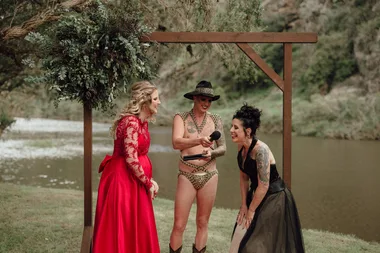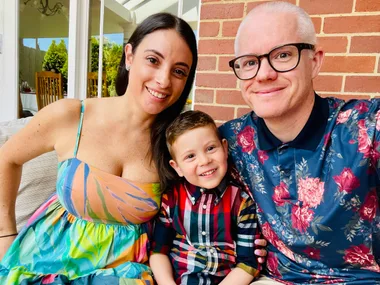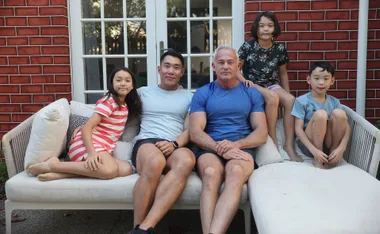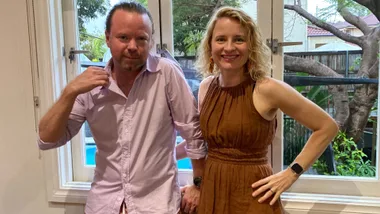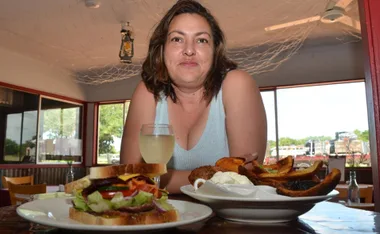- As a young girl, Wenn considered herself a tomboy but went on to marry a man and birth four children
- One day, Beatrice, an au pair, came into her life and the pair fell in love
- Wenn left her husband to be with her and later, they married
- Years later, someone mentioned that Wenn might actually be trans and it was a revelation
- Wenn confessed to Beatrice that deep down, he was a man and although taken aback, Beatrice agreed to support Wenn on his transition journey
- Wenn Lawson, from Weenambool, Vic., shares his story of how he finally transitioned to become a man at 62…
Standing in front of the toilet, I furrowed my brow in confusion as urine splashed all over the toilet seat and onto the floor.
Why can I never get it in the bowl? I wondered.
I was eight and was trying to stand and pee like all the other boys.
Only, I wasn’t a boy.
As I got older and things became more apparent, I considered myself a tomboy.
I was interested in engines and motorbikes and much preferred male company to female.
When I was 10 and my period started, I went into complete denial about it.
I refused to acknowledge what was happening to me and wear pads.
“You’ve got blood on your clothes,” a classmate told me.
“It’s not mine,” I replied.
In 1972, aged 20, I married a man. He owned a motorbike I liked, and that drew me to him.
Read more: Married with kids… then we found out we’re cousins!

A year after marriage, we lived on the grounds of a large home in the UK, as we waited for a council home to become available.
In the years that we lived there, I gave birth to four children. But outside of trying to conceive them, I never wanted to have sex.
I’d constantly withdraw from my husband or make excuses, which drove a wedge between us.
After 10 years of living there, a woman named Beatrice started work in the main house as an au pair.
Beatrice was Swiss and didn’t speak English, so the family asked if I could teach her what she needed to do around the house.
“I’d love to,” I told them.
The connection between Beatrice and me was instant.
I always wanted to be around her and thought she felt the same way about me.
My suspicions were confirmed one night when she kissed me.

It took me by surprise, but it sent a wave of electricity through me.
“Good night,” she smiled, before walking off and leaving me dumbstruck.
After that, we’d steal kisses and cuddles with each other when we could, but guilt soon consumed me.
I was a married woman, and I was betraying my husband. I was also a practising Christian, and having a same-sex relationship was forbidden.
In 1984, my family and I moved to Australia.
Beatrice came to live with us for six months.
Then she was back and forth from Europe to Australia on different visas.
When she was away, I missed her terribly.
Then, one day, after confiding in a counsellor at church, she put things into perspective.
“You’re carrying a dead relationship,” she said. “It’s a carcass that needs a funeral, called a divorce.”
Her words freed me.
She’s right, I thought.
After 19 years with my husband, I ended my marriage. He was furious, but my mind was made up.
When I told Beatrice, she was ecstatic.

And a year later, in 1991, she was granted a visa to live in Australia permanently.
Seeing her again made my heart soar.
“We can finally be together,” I grinned.
We kept our relationship under wraps in public, but eventually, my church group found out, and I was asked to leave. I was devastated.
But I still had Beatrice and my family, which meant the world to me. Madly in love, we tied the knot.
Then, in 2013, I was being driven to the airport after speaking at a conference about autism, which I’d been diagnosed with at 42, when the driver surprised me.
“You remind me of a lot of the trans people I used to work with,” she told me.
“What do you mean?” I asked, stunned.
“Have you ever considered that you might be a man in a woman’s body?” she asked.
From there, the seed was planted.
Back home, I was eager to speak to Beatrice about it.
“I need to tell you something,” I said.
I was sure she’d be completely understanding about me being trans. But she was horrified.
“I won’t pursue anything without your support,” I assured her. “You mean too much to me.”
“I could never forgive myself if you have come to this awareness that you are male, and I stop you from finding out,” she said.

We agreed I would go to see a psychiatrist.
Eight months later, I still hadn’t got a diagnosis of gender dysphoria from the doctor. He seemed to be reluctant, and I feared it had to do with my autism.
So, I decided to see a gender psychiatrist while I was visiting London.
I explained my journey and showed pictures from childhood, where I was wearing trousers and shorts and never a dress or skirt.
“There’s no doubt in my mind you have gender dysphoria,” he said.
I left and found Beatrice outside. I revealed what the psychiatrist had said.
“I can’t promise you how this will impact me,” she said. “But I’m fully on-board and will ride the storm.”
“That means so much to me,” I told her.
Back in Australia, I told my psychiatrist about my diagnosis. Happy with a second opinion, he authorised my transition.
I started taking testosterone gel, and on the first application, everything suddenly felt right.
To make things easier for everyone, I changed my name to Wenn, a shortened version of my female name, Wendy.
When I sat my kids down and told them, they weren’t at all surprised.
“We’ve always known,” my daughter said.
Their only request was that they could still call me Mum.

In 2014, aged 62, I had surgery. We’re now a decade on, and I have no regrets about my decision.
This is precisely where I’m meant to be. Luckily, Beatrice, 62, stuck by me.
“It’s you I love, not your gender,” she told me.
We even remarried as man and wife.
We’ve now been together for 40 years, and I can’t imagine living without her.

